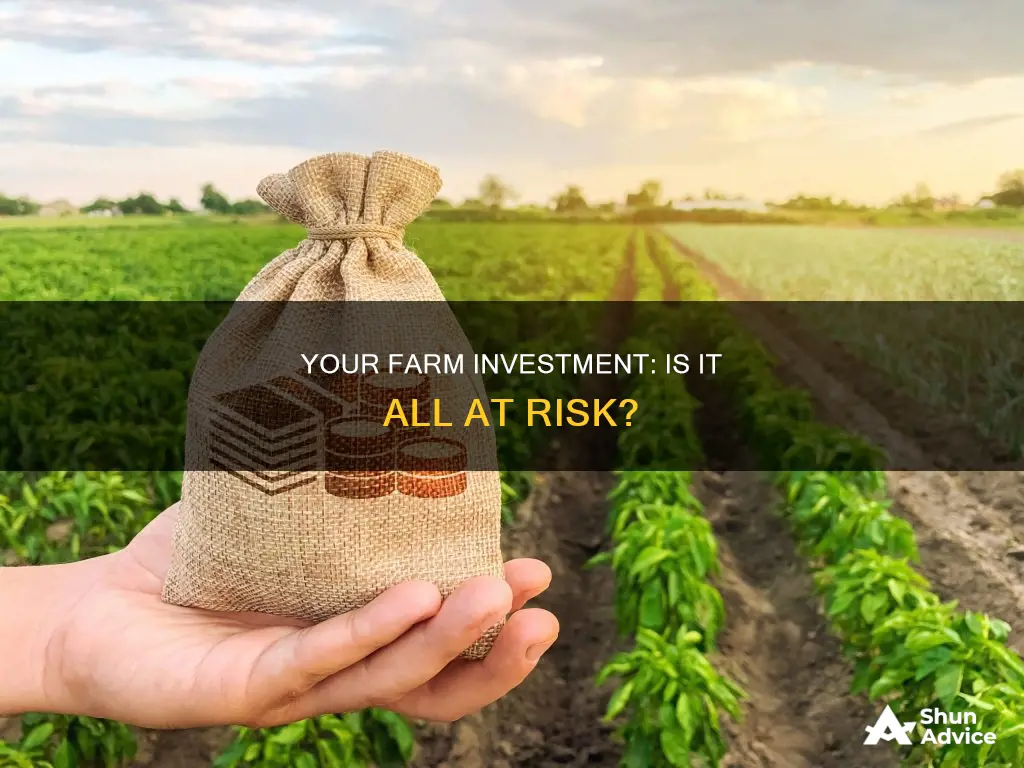
Investing in a farm comes with a variety of risks, and it is important to understand how these risks could impact your investment. The at-risk rules place a limit on the amount of loss that can be deducted from your taxable business activities. This limit is based on the actual amount of money that you stand to lose. If you are not at risk of losing your investment, for example, if you are not personally responsible for a loan used to finance the business, then any resulting loss would be limited to the amount you would actually lose. This is known as the At-Risk Limitation, and the allowed amount of loss is reported on Form 6198.
The at-risk rules cover any trade or business activity, as well as investment activity, and apply to individuals, estates, trusts, and some closely held corporations. As a farm business owner, your amount at risk includes money contributed to the activity, debts for which you are personally liable, and the fair market value of any property (adjusted for any liens) that is not used in the activity but which you pledge as security for the debts of the activity.
It is worth noting that having insurance will not render you not at risk for income tax purposes, even though it does reduce the risk of loss. Additionally, the at-risk rules may not limit deductions for many small businesses because the at-risk amount often exceeds the losses from the business.
Other risks to consider when investing in a farm include operational risk, commodity price and land value risk, and limited liquidity. Operational risk refers to the potential success or failure of a farmer's operation, which can be influenced by various factors, including weather events. Commodity price risk refers to the potential negative impact of falling commodity prices on the market outlook for the crops produced. This can hurt your profits or affect the farmer's ability to pay rent. Land value risk refers to the potential for farmland prices to fall below what you originally paid, which could be a result of extreme economic pressures. Finally, limited liquidity refers to the inability to sell your land when you want or need to get your original investment back.
Understanding and carefully considering these risks will help you make informed decisions when investing in a farm and develop strategies to mitigate potential losses.
What You'll Learn
- The at-risk rules place a limit on the dollar amount of any loss that a taxpayer can deduct from their business activities
- The at-risk rules cover any trade or business activity as well as any investment activity
- The amount at risk for the producer includes money contributed to the activity plus debts for which the producer is personally liable
- The at-risk rules may not limit deductions for many small businesses because the at-risk amount exceeds the losses from the business
- The at-risk rules are separate from the passive loss rules, which may also apply

The at-risk rules place a limit on the dollar amount of any loss that a taxpayer can deduct from their business activities
The at-risk rules limit the amount of loss that a taxpayer can deduct from their business activities to the dollar value. This amount is based on the actual amount of money the taxpayer could lose. Typically, the loss that can be deducted is limited to the actual investment made by the taxpayer in a business, plus any amounts that the taxpayer is personally liable for.
When a taxpayer is not at risk of losing their investment, such as when loans are used to finance business activity and the taxpayer is not personally responsible for the loan, any resulting loss from that activity would be limited to the amount the taxpayer would actually lose. This concept is called the "At-Risk Limitation", and the allowed amount of any loss is reported on Form 6198, filed with the tax return.
Form 6198 is used to determine the profit or loss from an at-risk activity for the current year, the amount at risk for the current year, and the deductible loss for the current year. It should be filed when a taxpayer has a loss in a business activity reported on a Schedule C, E, or F, and some or all of their investment is not at risk.
A taxpayer is considered at risk in an activity to the extent of cash plus the adjusted basis of other property they have contributed to the activity, along with certain amounts borrowed for use in the activity that the taxpayer is personally liable for.
The at-risk rules were intended to help guarantee that losses claimed on returns are valid and that taxpayers do not attempt to manipulate their taxable income using tax shelters.
Interactive Corp's Investment Strategies: Exploring Their Approach
You may want to see also

The at-risk rules cover any trade or business activity as well as any investment activity
The at-risk rules apply to any trade or business activity as well as any investment activity. The rules limit the amount of allowable deductions that an individual or closely held corporation can claim for tax purposes as a result of engaging in specific activities that can result in financial losses. These rules were introduced to ensure that losses claimed on returns are valid and that taxpayers do not manipulate their taxable income using tax shelters.
The at-risk rules apply to individuals (including partners and S corporation shareholders), estates, trusts, and certain closely held C corporations. A closely held C corporation is defined by the number of individuals with ownership stakes in the company. For the at-risk rules, a C corporation is a closely held corporation if more than 50% in value of its outstanding stock is owned, directly or indirectly, by or for five or fewer individuals.
The at-risk rules cover a range of activities, including:
- Holding, producing, or distributing motion picture films or video tapes.
- Leasing section 1245 property, including personal property and certain other tangible property that is depreciable or amortizable.
- Exploring for, or exploiting, oil and gas.
- Exploring for, or exploiting, geothermal deposits (for wells started after September 1978).
- Any other activity not included in the previous categories that is carried on as a trade or business or for the production of income.
The at-risk rules do not apply to the holding of real property placed in service before 1987. They also do not apply to the holding of an interest acquired before 1987 in a pass-through entity engaged in holding real property placed in service before 1987. This exception does not include holding mineral property.
The amount an investor has at risk is calculated by combining the amount of their investment in the activity with any amount they have borrowed or are liable for with respect to that particular investment. This amount is measured annually at the end of the tax year and can be increased or decreased in several ways.
Smart Strategies to Earn 100K: Where to Invest This Year
You may want to see also

The amount at risk for the producer includes money contributed to the activity plus debts for which the producer is personally liable
When it comes to farming, there are various factors that can influence the amount at risk for the producer. This includes both the money they have contributed to the activity and any debts for which they are personally liable.
Firstly, the producer's investment in the farm is at risk. This means that any money they have contributed directly to the farm's operations, such as purchasing equipment, land, or inventory, is vulnerable to loss. The producer's investment is directly tied to the success or failure of the farm, and they stand to lose their investment if the farm underperforms or faces financial difficulties.
Additionally, the producer may be personally liable for certain debts related to the farm. This means that if the farm incurs debts, such as loans, credit lines, or accounts payable, and is unable to repay them, the creditors can legally pursue the producer for repayment. This personal liability depends on the business structure and can vary based on whether the producer operates as a sole proprietorship, partnership, or limited liability entity.
To assess the amount at risk, it is essential to consider both the producer's investment and their personal liability for farm-related debts. This combined figure represents the total financial exposure the producer faces in the event of financial challenges or setbacks in the farming activity.
It is worth noting that there may be ways to mitigate risk, such as through insurance or by structuring the farming activity as a separate legal entity. However, the specific circumstances and applicable laws will determine the level of protection offered to the producer.
Overall, understanding the amount at risk for the producer is crucial for financial planning, risk management, and making informed decisions regarding the farming activity.
Understanding Investment Management Services: Strategies for Success
You may want to see also

The at-risk rules may not limit deductions for many small businesses because the at-risk amount exceeds the losses from the business
The at-risk rules are tax shelter laws that limit the amount of allowable deductions that an individual or closely held corporation can claim for tax purposes as a result of engaging in specific activities that can result in financial losses. A closely held corporation is defined by the IRS as a corporation in which more than 50% of its outstanding stock is owned by five or fewer individuals at any time during the last half of the tax year.
The at-risk rules cover any trade or business activity as well as any investment activity. The application of these rules is not limited to investments that produce portfolio income (interest or dividends) or loss or passive income (rent) or loss. The limits on deductions apply to individuals, estates, trusts, and some closely held corporations.
The at-risk rules place a limit on the dollar amount of any loss that a taxpayer can deduct from their business activities. This amount is generally based on the actual amount of money that the taxpayer stands to lose. Typically, a loss that can be deducted by the taxpayer is limited to the actual investment that the taxpayer has made in a business plus any amounts that the taxpayer is personally liable for.
The amount that a taxpayer has at risk (also called their "at-risk basis") is measured annually at the end of the tax year. An investor's at-risk basis is calculated by combining the amount of the investor's investment in the activity with any amount that the investor has borrowed or is liable for with respect to that particular investment. An investor's at-risk basis may be increased annually if the investor made any additional contributions to the investment or by the amount of income they receive from the investment (in excess of deductions). At-risk basis is decreased annually by the amount by which deductions exceed income and distributions.
The at-risk rules are intended to prevent investors from writing off more than the amount they invested in a business, generally a flow-through entity. Businesses structured as flow-through entities include S corporations, partnerships, trusts, and estates. A taxpayer cannot deduct any more than the amount of money that they had at risk at the end of the tax year in any activity for which the taxpayer was not a material participant.
Smart Saving and Investing Strategies for Your Kids' Future
You may want to see also

The at-risk rules are separate from the passive loss rules, which may also apply
The at-risk rules refer to the amount of capital or assets you have invested in an activity, such as a farm, that can be lost if the investment fails or does not perform as expected. These rules determine the extent of your financial risk and exposure. Essentially, they define the maximum amount you stand to lose. This is separate from the passive loss rules, which govern how you can use losses to reduce your taxable income.
The passive loss rules, on the other hand, relate to the tax treatment of losses from passive activities, which include rental properties and business ventures where the investor does not actively participate. These rules outline whether and how investors can use these losses to offset income from other sources for tax purposes.
For example, if you have a farm that generates a loss, the passive loss rules will determine if and how you can use that loss to reduce your taxable income from other sources, such as salary or investments. These rules are designed to prevent investors from using losses in one area to offset income in another, unless certain conditions are met.
It is important to note that the at-risk rules and the passive loss rules interact. While they are separate concepts, the amount you have "at risk" in an investment can impact the application of the passive loss rules. If your investment is not fully at risk—that is, there is a level of protection or guarantee—then you may be restricted in using any losses generated to offset other income under the passive loss rules.
In summary, while the at-risk rules define the maximum exposure of your investment, the passive loss rules govern how any losses from the investment can be applied for tax purposes. Both sets of rules are important for understanding the potential risks and tax implications of investing in a farm or any other similar venture.
Duke Energy's Investment Decision-Making: Strategy and Factors
You may want to see also
Frequently asked questions
It means that you could lose the entire amount that you have invested in the farm business. This includes both the money you have contributed and any property you have pledged as security for loans.
The At-Risk Limitation is a concept that places a limit on the amount of loss that a taxpayer can deduct from their business activities. This limit is typically based on the actual amount of money that the taxpayer stands to lose.
The At-Risk rules cover any trade or business activity, including farming. These rules limit the deduction of losses to the amount that the producer has at risk, which is the amount the taxpayer could actually lose from the activity.
The amount at risk can be increased by contributing additional cash or property, allocating income produced by the venture to the individual, or refinancing a loan. It can be decreased by an investor withdrawing cash or property from the activity or changing their share of losses.
Yes, farmland investing has its own set of risks, including operational risk, commodity price and land value risk, and limited liquidity. Operational risk refers to the potential success or failure of a farmer's operation, which can be affected by weather events, water allocation, pests, or financial setbacks. Commodity price risk refers to the potential negative impact of falling commodity prices on the market outlook for crops. Limited liquidity refers to the inability to sell your land when you want or need to.







